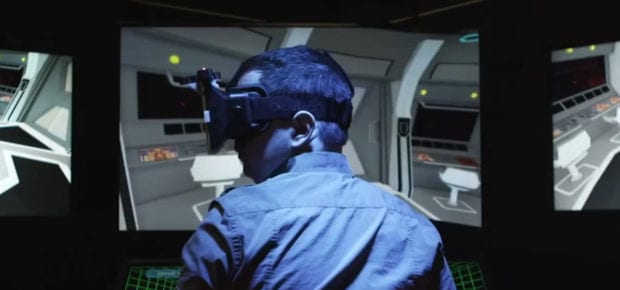December 27, 2018
As part of our video series on virtual reality (VR), we recently spoke with the leaders of the MxR lab at the USC Institute for Creative Technologies and the Tech and Narrative lab at Pardee RAND Graduate School, which develop serious immersive education and training simulations:
Among those sharing their insights was the Tech & Narrative lab’s director, IEEE Member Todd Richmond, who highlighted some key distinctions between consumer VR devices and those used to prepare troops and others for very specific real-world scenarios.
“Fundamentally, for so-called serious applications and serious games, there’s a ground truth that you’re held accountable to. And on the entertainment side, you don’t have that; in fact, there’s a term for it – game physics – that you’re not held to that standard of Newtonian physics,” says Richmond.
Being removed from physics is often what we consumers crave – a sense of departure from the real world, a sense that anything is possible. And in that pursuit, we’re also increasingly adamant that the experiences look as fluid and polished as possible.
For Richmond and his team, that flair isn’t required to generate a meaningful program. In fact, it may have the opposite effect: “We’re big fans of abstraction, because really, at the core, we’re trying to understand what are the things you really need to train someone on. And all of the shiny objects and the beautiful graphics could actually get in the way.”
While researchers on the serious applications side refine for minimalism and effectiveness, consumer-facing companies are pushing the limits of VR graphics to create desirable new devices. Take this impressive example written about by IEEE Future Directions: a headset with a double display to create a sense of distance and focus.
By using two screens, one that shows a wide-angle view with low resolution and one that shows a smaller, high-resolution image, the two can merge and let the brain process vision as it normally does, resulting in a much more realistic experience. Advances like this could feasibly find their way into serious applications and games in due time.
Further research is being done on focal distance and the optimal brightness of virtual objects when it comes to making near-field depths feel accurate and believable in VR. There’s also new work on controlling VR environments exclusively using the brain, although the potential impact of this on real-world training is a bit less clear.
Richmond sums it up well: “We have hundreds, if not thousands, of years of figuring out how to represent image and represent story within a bounded screen environment. VR and AR essentially destroy those boundaries.” By removing the reference point that screens provided, we’re in a realm that’s quite different from TV and film, and it’ll take more time to figure out which technologies will allow us to get the most out of VR for serious and entertainment applications alike.






 Bits, Bytes, Buildings and Bridges: Digital-Driven Infrastructure
Bits, Bytes, Buildings and Bridges: Digital-Driven Infrastructure Impact of Technology in 2024
Impact of Technology in 2024 Emerging AI Cybersecurity Challenges and Solutions
Emerging AI Cybersecurity Challenges and Solutions The Skies are Unlimited
The Skies are Unlimited Smart Cities 2030: How Tech is Reshaping Urbanscapes
Smart Cities 2030: How Tech is Reshaping Urbanscapes Impact of Technology 2023
Impact of Technology 2023 Cybersecurity for Life-Changing Innovations
Cybersecurity for Life-Changing Innovations Smarter Wearables Healthier Life
Smarter Wearables Healthier Life Infrastructure In Motion
Infrastructure In Motion The Impact of Tech in 2022 and Beyond
The Impact of Tech in 2022 and Beyond Cybersecurity, Technology and Protecting Our World
Cybersecurity, Technology and Protecting Our World How Technology Helps us Understand Our Health and Wellness
How Technology Helps us Understand Our Health and Wellness The Resilience of Humanity
The Resilience of Humanity Harnessing and Sustaining our Natural Resources
Harnessing and Sustaining our Natural Resources Creating Healthy Spaces Through Technology
Creating Healthy Spaces Through Technology Exceptional Infrastructure Challenges, Technology and Humanity
Exceptional Infrastructure Challenges, Technology and Humanity The Global Impact of IEEE's 802 Standards
The Global Impact of IEEE's 802 Standards Scenes of our Cyber Lives: The Security Threats and Technology Solutions Protecting Us
Scenes of our Cyber Lives: The Security Threats and Technology Solutions Protecting Us How Millennial Parents are Embracing Health and Wellness Technologies for Their Generation Alpha Kids
How Millennial Parents are Embracing Health and Wellness Technologies for Their Generation Alpha Kids Space Exploration, Technology and Our Lives
Space Exploration, Technology and Our Lives Global Innovation and the Environment
Global Innovation and the Environment How Technology, Privacy and Security are Changing Each Other (And Us)
How Technology, Privacy and Security are Changing Each Other (And Us) Find us in booth 31506, LVCC South Hall 3 and experience the Technology Moon Walk
Find us in booth 31506, LVCC South Hall 3 and experience the Technology Moon Walk Virtual and Mixed Reality
Virtual and Mixed Reality How Robots are Improving our Health
How Robots are Improving our Health IEEE Experts and the Robots They are Teaching
IEEE Experts and the Robots They are Teaching See how millennial parents around the world see AI impacting the lives of their tech-infused offspring
See how millennial parents around the world see AI impacting the lives of their tech-infused offspring Take the journey from farm to table and learn how IoT will help us reach the rising demand for food production
Take the journey from farm to table and learn how IoT will help us reach the rising demand for food production Watch technical experts discuss the latest cyber threats
Watch technical experts discuss the latest cyber threats Explore how researchers, teachers, explorers, healthcare and medical professionals use immersive technologies
Explore how researchers, teachers, explorers, healthcare and medical professionals use immersive technologies Follow the timeline to see how Generation AI will be impacted by technology
Follow the timeline to see how Generation AI will be impacted by technology Learn how your IoT data can be used by experiencing a day in a connected life
Learn how your IoT data can be used by experiencing a day in a connected life Listen to technical experts discuss the biggest security threats today
Listen to technical experts discuss the biggest security threats today See how tech has influenced and evolved with the Games
See how tech has influenced and evolved with the Games Enter our virtual home to explore the IoT (Internet of Things) technologies
Enter our virtual home to explore the IoT (Internet of Things) technologies Explore an interactive map showcasing exciting innovations in robotics
Explore an interactive map showcasing exciting innovations in robotics Interactively explore A.I. in recent Hollywood movies
Interactively explore A.I. in recent Hollywood movies Get immersed in technologies that will improve patients' lives
Get immersed in technologies that will improve patients' lives